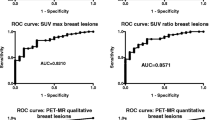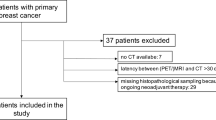Abstract
Purpose
The main objective of this study was to determine the efficacy of 18F-fluorodeoxyglucose positron emission tomography (FDG PET) to assess the impact of this technique in staging of patients with newly diagnosed breast cancer.
Methods
Two hundred and seventy-one consecutive patients (median age = 51 ± 11 years) with biopsy-proven primary breast cancer who were examined by FDG PET were enrolled in this prospective preoperative staging study. Whole-body FDG-PET images were acquired approximately 60 min after the intravenous administration of FDG (5.2 MBq/kg). Visual assessment and the maximum standardized uptake value (SUVmax) of breast lesions for semiquantitative analysis were carried out. The PET results were compared with the histopathology results.
Results
For the tumor, node, metastases (TNM) staging, 240 patients (250 breasts) were considered eligible based on the criteria that were established for this analysis. Significant differences were noted in SUVmax of lesions according to the TNM staging (p < 0.05). The average SUVmax of the primary tumor was calculated in patients with axillary involvement (n = 58) and for the ones without axillary metastasis (n = 79), and SUVmax were 4.1 ± 3.5 and 2.8 ± 2.3, respectively, with a significant difference between the two groups (p = 0.03). PET imaging revealed pathological FDG uptake in 54% (46/85) of patients with axillary lymph node metastases. The sensitivities of FDG PET for detecting axillary lymph node metastasis were found 41% in pN1, 67% in pN2, and 100% in pN3, and the specificity was 89% for pN0 stage. Detection of extra-axillary regional node or distant metastatic lesions revealed by PET scan in 22 of 24 patients resulted in a significant change in the TNM stage. Distant metastasis without axillary lymph node metastasis was noted in 21% (5/24) of patients. The results revealed that FDG PET upgraded TNM stage in 9.2% (22/240) of patients and 7.5% (18/240) of patients were diagnosed as having one or more distant metastases.
Conclusion
FDG PET was able to identify extra-axillary regional nodal and distant lesions in newly diagnosed patients with breast cancer; FDG PET may alter the staging and management of therapy in patients with newly diagnosed breast cancer.

Similar content being viewed by others
References
Jemal A, Murray T, Ward E, et al. Cancer statistics, 2005. CA Cancer J Clin 2005;55:10–30.
Scheidhauer K, Walter C, Seemann MD. FDG PET and other imaging modalities in the primary diagnosis of suspicious breast lesions. Eur J Nucl Med Mol Imaging 2004;31 Suppl 1:S70–9.
Bomanji JB, Costa DC, Ell PJ. Clinical role of positron emission tomography in oncology. Lancet Oncol 2001;2:157–64.
Hustinx R, Benard F, Alavi A. Whole-body FDG-PET imaging in the management of patients with cancer. Semin Nucl Med 2002;32:35–46.
Eubank WB, Mankoff D, Bhattacharya M, et al. Impact of FDG PET on defining the extent of disease and on the treatment of patients with recurrent or metastatic breast cancer. AJR Am J Roentgenol 2004;183:479–86.
Dose J, Bleckmann C, Bachmann S, et al. Comparison of fluorodeoxyglucose positron emission tomography and “conventional diagnostic procedures” for the detection of distant metastases in breast cancer patients. Nucl Med Commun 2002;23:857–64.
Gallowitsch HJ, Kresnik E, Gasser J, et al. F-18 fluorodeoxyglucose positron-emission tomography in the diagnosis of tumor recurrence and metastases in the follow-up of patients with breast carcinoma: a comparison to conventional imaging. Invest Radiol 2003;38:250–6.
van der Hoeven JJ, Hoekstra OS, Comans EF, et al. Determinants of diagnostic performance of [F-18]fluorodeoxyglucose positron emission tomography for axillary staging in breast cancer. Ann Surg 2002;236:619–24.
Bellon JR, Livingston RB, Eubank WB, et al. Evaluation of the internal mammary lymph nodes by FDG-PET in locally advanced breast cancer (LABC). Am J Clin Oncol 2004;27:407–10.
Greco M, Crippa F, Agresti R, et al. Axillary lymph node staging in breast cancer by 2-fluoro-2-deoxy-D-glucose-positron emission tomography: clinical evaluation and alternative management. J Natl Cancer Inst 2001;93:630–5.
Crippa F, Agresti R, Seregni E, et al. Prospective evaluation of fluorine-18-FDG PET in presurgical staging of the axilla in breast cancer. J Nucl Med 1998;39:4–8.
Adler LP, Faulhaber PF, Schnur KC, Al-Kasi NL, Shenk RR. Axillary lymph node metastases: screening with [F-18]2-deoxy-2-fluoro-D-glucose (FDG) PET. Radiology 1997;203:323–7.
Utech CI, Young CS, Winter PF. Prospective evaluation of fluorine-18 fluorodeoxyclucose positron emission tomography in breast cancer for staging of the axilla related to surgery and immunocytochemistry. Eur J Nucl Med 1996;23:1588–93.
Smith IC, Ogston KN, Whitford P, et al. Staging of the axilla in breast cancer: accurate in vivo assessment using positron emission tomography with 2-(fluorine-18)-fluoro-2-deoxy-D-glucose. Ann Surg 1998;228:220–7.
Schirrmeister H, Kuhn T, Guhlmann A, et al. Fluorine-18 2-deoxy-2-fluoro-D-glucose PET in the preoperative staging of breast cancer: comparison with the standard staging procedures. Eur J Nucl Med 2001;28:351–8.
Wahl RL, Siegel BA, Coleman RE, Gatsonis CG; PET Study Group. Prospective multicenter study of axillary nodal staging by positron emission tomography in breast cancer: a report of the staging breast cancer with PET Study Group. J Clin Oncol 2004;22:277–85.
American Joint Committee on Cancer. Breast. In: AJCC, editor. AJCC Cancer Staging Manual, 6th ed. Berlin, Heidelberg, New York: Springer; 2002. p. 171–80.
Avril N, Rose CA, Schelling M, et al. Breast imaging with positron emission tomography and fluorine-18 fluorodeoxyglucose: use and limitations. J Clin Oncol 2000;18:3495–502.
Schirrmeister H, Kuhn T, Guhlmann A, et al. Fluorine-18 2-deoxy-2-fluoro-D-glucose PET in the preoperative staging of breast cancer: comparison with the standard staging procedures. Eur J Nucl Med 2001;28:351–8.
Oshida M, Uno K, Suzuki M, et al. Predicting the prognoses of breast carcinoma patients with positron emission tomography using 2-deoxy-2-fluoro[18F]-D-glucose. Cancer 1998;82:2227–34.
Avril N, Menzel M, Dose J, et al. Glucose metabolism of breast cancer assessed by 18F-FDG PET: histologic and immunohistochemical tissue analysis. J Nucl Med 2001;42:9–16.
Bos R, van Der Hoeven JJ, van Der Wall E, et al. Biologic correlates of (18)fluorodeoxyglucose uptake in human breast cancer measured by positron emission tomography. J Clin Oncol 2002;20:379–87.
Buck A, Schirrmeister H, Kuhn T, et al. FDG uptake in breast cancer: correlation with biological and clinical prognostic parameters. Eur J Nucl Med Mol Imaging 2002;29:1317–23.
Avril N, Bense S, Ziegler SI, et al. Breast imaging with fluorine-18-FDG PET: quantitative image analysis. J Nucl Med 1997;38:1186–91.
Adams S, Baum RP, Stuckensen T, Bitter K, Hor G. Prospective comparison of 18F-FDG PET with conventional imaging modalities (CT, MRI, US) in lymph node staging of head and neck cancer. Eur J Nucl Med 1998;25:1255–60.
Lovrics PJ, Chen V, Coates G, et al. A prospective evaluation of positron emission tomography scanning, sentinel lymph node biopsy, and standard axillary dissection for axillary staging in patients with early stage breast cancer. Ann Surg Oncol 2004;11:846–53.
Eubank WB, Mankoff DA, Takasugi J, et al. 18fluorodeoxyglucose positron emission tomography to detect mediastinal or internal mammary metastases in breast cancer. J Clin Oncol 2001;19:3516–23.
Wu D, Gambhir SS. Positron emission tomography in diagnosis and management of invasive breast cancer: current status and future perspectives. Clin Breast Cancer. 2003;Suppl 1:S55–63.
Ravaioli A, Pasini G, Polselli A, et al. Staging of breast cancer: new recommended standard procedure. Breast Cancer Res Treat 2002;72:53–60.
Gerber B, Seitz E, Muller H, et al. Perioperative screening for metastatic disease is not indicated in patients with primary breast cancer and no clinical signs of tumor spread. Breast Cancer Res Treat 2003;82:29–37.
Schneider C, Fehr MK, Steiner RA, Hagen D, Haller U, Fink D. Frequency and distribution pattern of distant metastases in breast cancer patients at the time of primary presentation. Arch Gynecol Obstet 2003;269:9–12.
Vranjesevic D, Filmont JE, Meta J, et al. Whole-body (18)F-FDG PET and conventional imaging for predicting outcome in previously treated breast cancer patients. J Nucl Med 2002;43:325–9.
Weir L, Worsley D, Bernstein V. The value of FDG positron emission tomography in the management of patients with breast cancer. Breast J 2005;11:204–9.
Braun S, Vogl FD, Naume B, et al. A pooled analysis of bone marrow micrometastasis in breast cancer. N Engl J Med 2005;353:793–802.
Acknowledgements
This work was supported by U.S. Public Health Services Research Grant M01-RR00040 from the National Institutes of Health. This work was also supported in part by the International Union against Cancer, Geneva, Switzerland, under the ACSBI fellowship. The authors would like to thank Janet Saffer, Ph.D., for her valuable assistance in analyzing data from this study.
Author information
Authors and Affiliations
Corresponding author
Rights and permissions
About this article
Cite this article
Çermik, T.F., Mavi, A., Basu, S. et al. Impact of FDG PET on the preoperative staging of newly diagnosed breast cancer. Eur J Nucl Med Mol Imaging 35, 475–483 (2008). https://doi.org/10.1007/s00259-007-0580-5
Received:
Accepted:
Published:
Issue Date:
DOI: https://doi.org/10.1007/s00259-007-0580-5




